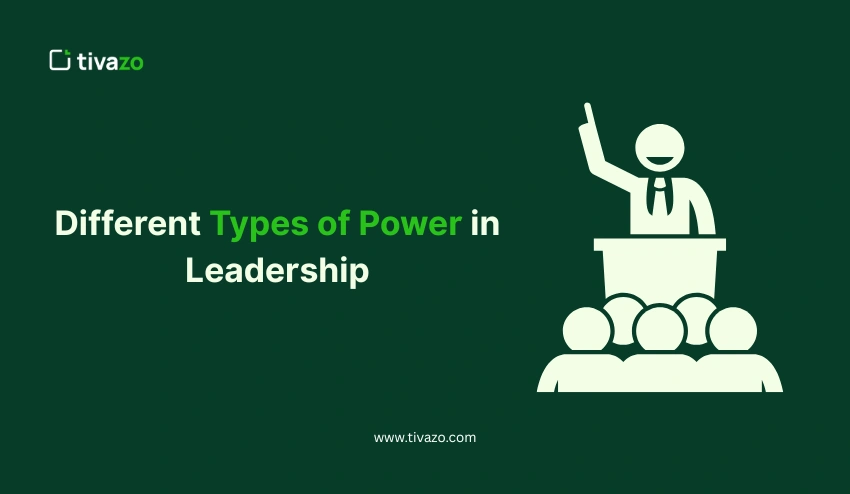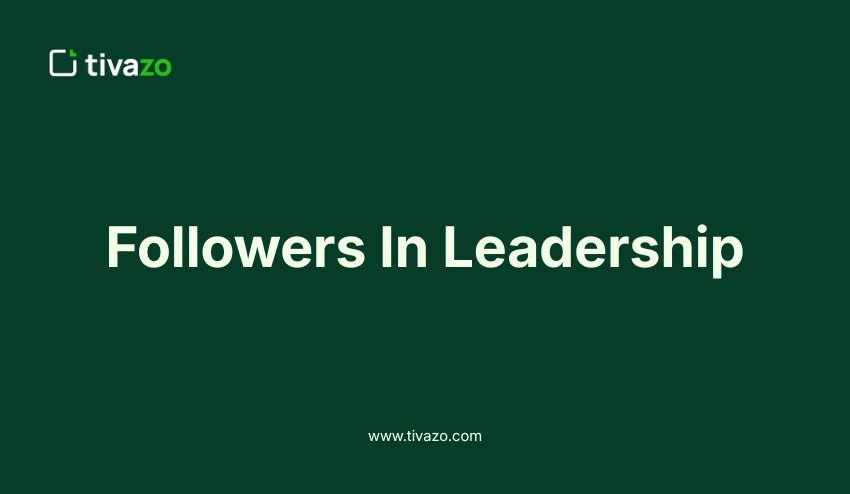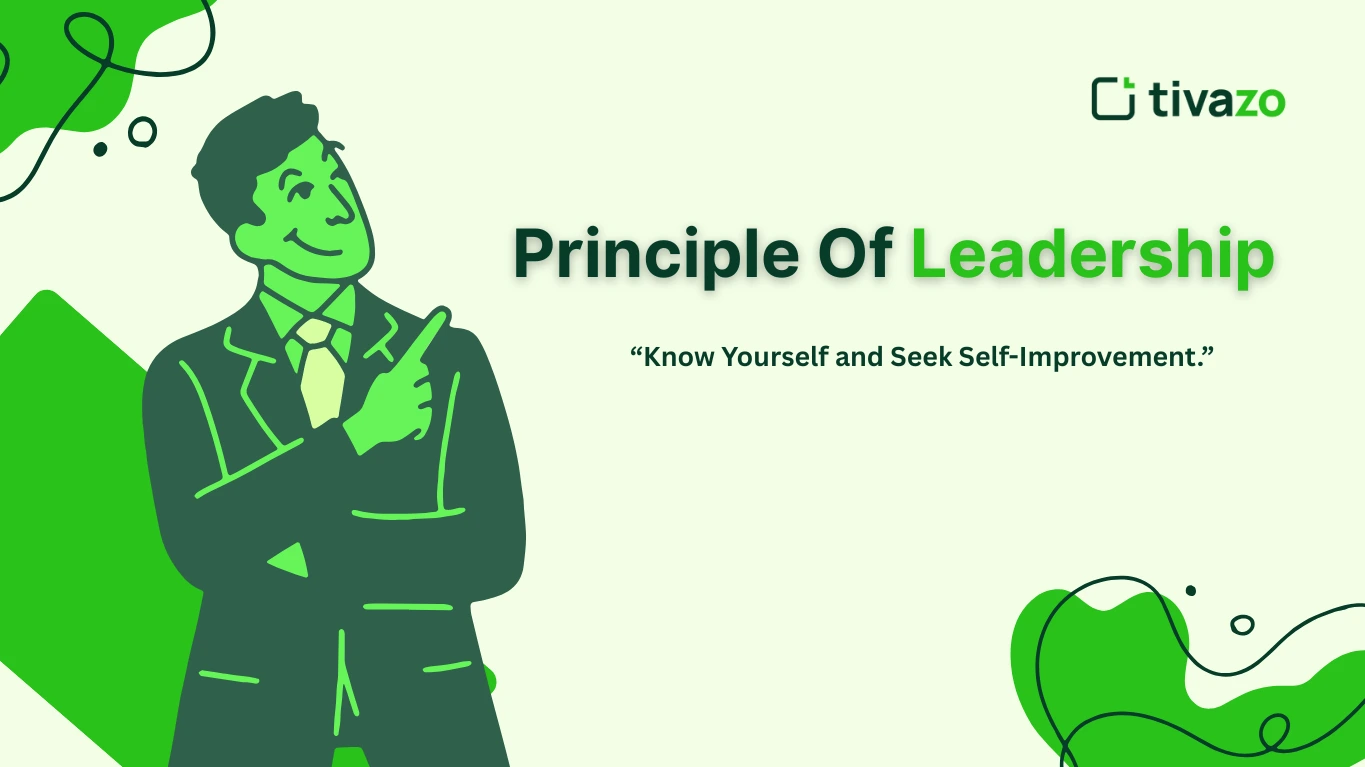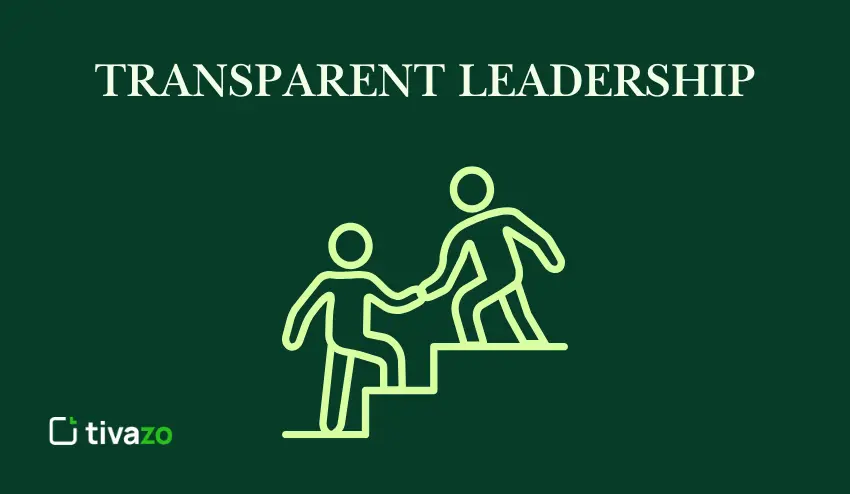Being a leader is not a title or a power, but an influence. Not all types of power in leadership are equal, and every successful leader has power. Others motivate groups, whereas others might influence them to resist or even be unintentionally demotivating.
It is important to understand the types of power in leadership, as well as any person who wants to be a guiding power of a team, make effective decisions, and promote a good organizational culture. Expert power, which is founded on skills and knowledge, refers to power founded on respect and admiration, and even the informational or connection power that impacts the decision-making; each type of power exhibits a unique impact on influencing other people.
In the contemporary changing work environment, leaders need to strike a balance between positional and personal power in order to realize outcomes. The classic framework created by French and Raven, and the contemporary extensions, emphasize the strategic use of reward, coercive, moral, and charismatic power. The ability to apply each type at the right time and in the right way not only provides performance but also builds trust, engagement, and long-term loyalty. This guide will address all key types of power in leadership, examples in practice, and tips on how to use influence.
👉Related: How Do Leadership Styles and Effectiveness Shape Success?
What Is Leadership Power?
Leadership power is the ability of a leader to influence, guide, and motivate individuals or teams to achieve goals, regardless of their formal position. In U.S. organizations, from corporate offices in New York to tech startups in Silicon Valley, effective leadership power combines authority, expertise, and personal influence to drive performance and decision-making.
10 Types of Power in Leadership
This is critical because leaders who desire to impact teams, achieve outcomes, and have a good organizational culture should understand the types of power in leadership. All of the types have different methods of motivating, guiding, and inspiring employees through difficulty in contemporary workplaces.
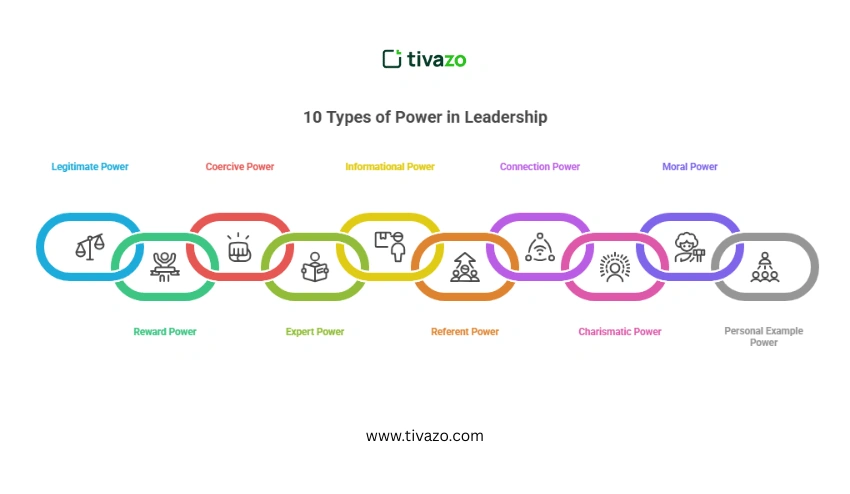
1. Legitimate Power
The legitimate power is based on the formal position or title of a leader and allows him/her to make decisions, delegate responsibilities, and establish policies. The given type of positional power is inherent in the structured settings, such as corporations, government offices, and educational institutions, where visibility and responsibility are paramount.
A CEO who has instituted strategic initiatives or a head of the department who has led the teamwork has legitimate power because the employees will obey the instructions given by the leader because of the position he is supposed to hold. These types of power in leadership influence offer organization, compliance, and stipulated hierarchies within the organization.
Nevertheless, excessive dependence on legitimate power may also be dictatorial and suppress creativity, diminishing team involvement. Combined with personal power, including expert power, referent power, or moral power, leaders will be able to establish authority and foster trust, cooperation, and willingness to seek voluntary commitment on their part.
2. Reward Power
Reward power helps the leaders to have an effect on the behavior of the team by giving them rewards such as bonuses, promotion, recognition, or special privileges. Being one of the crucial types of power in leadership influence, it helps motivate employees to achieve the objectives, strengthens positive behaviors, and improves productivity.
Reward power is effective when managers reward employees who make achievements, have career growth opportunities, or use performance-based rewards. The most effective reward power, according to the leadership studies, is the one under which employees can see the direct relationship between their efforts and tangible results, which results in loyalty and engagement.

However, too much use of rewards may alter the emphasis to extrinsic rewards, as opposed to internal drive or dedication to organizational objectives. The combination of reward power with the moral, referent, or expert power guarantees the balanced leadership that will inspire employees and increase trust, alignment, and long-term engagement.
3. Coercive Power
Coercive power is the power of the leaders to impose penalties or punishments to control behavior. This power of position guarantees that there is compliance or adherence to rules, policies, or deadlines within high-stakes or regulated environments, making it one of the key types of power in leadership.
A coercive power is used by a project manager who is strict in terms of deadlines or who implements corrective measures, for example. Its use under prudence will aid in maintaining discipline, enhancing accountability, and guarantee that teams perform to the organizational standards. The study on leadership indicates its effectiveness in situations that require urgent obedience or security.
Coercive power, however, may cause fear, lack of morale, and loss of trust when overused. Leaders who are able to employ both coercive power and referent, moral power, or expert power can create discipline and still maintain engagement, innovation, and voluntary commitment.
4. Expert Power
Expert power is achieved by knowledge, skills, or expertise of a leader, and a leader is more prone to be followed by others. This individual authority is essential in technical, creative, or strategic positions where informed decision-making is essential, making it a vital element among the types of power in leadership.
Such leaders as Elon Musk also convey expert power using technical expertise to direct groups and motivate creativity. Organizational studies indicate that expert power enhances credibility, fosters cooperation, and empowers leaders to make decisions in a way that can appeal to knowledge-based work environments.
Nevertheless, influence can be undermined by old-fashioned expertise or excessive confidence. Such leaders hold credibility and build trust and long-term impact of leadership in different teams because they are able to merge expert power with informational, moral, or referent power.
5. Informational Power
The power to control or even the dissemination of important knowledge that others can access is known as informational power, which is one of the critical types of power in leadership. Leaders with this power influence decisions, formulate strategy, and shape results through making relevant contributions.
The product manager who provides market research or trends information has informational power, and they can make informed and data-driven decisions. Research indicates that effective and open communication by leaders enhances trust, cohesiveness, and accuracy in decisions made by the team.
Informational power may cause misinformation or hoarding of knowledge when it is abused, making teams less credible. The informational power, in combination with expert, referent, or connection power, will guarantee that the leaders will have the most influence and will ensure transparency, collaboration, and engagement.
6. Referent Power
Referent power is achieved through admiration, respect, and personal appeal, whereby leaders are able to sway people at will. A leader who possesses referent power infuses loyalty, trust, and engagement, which provides a base of personal leadership influence.
Nelson Mandela was a good example of referent power, who obtained devotion due to his integrity, vision, and empathy. Research demonstrates that referent power enhances organizational culture, fosters cooperation, and motivates employees as people obey those whom they admire and respect.
Referent power can, however, be easily destroyed by ethical shortcomings or inconsistencies in behavior. Leaders who cultivate relationships, possess empathy and authenticity, and merge the referent power with the moral power or expert power in order to have a lasting influence.
📖Read More: What Is Referent Power and How Does It Shape Leadership?
7. Connection Power
Connection power relies on the network, relationships, and the capability of a leader to utilize contacts in order to accomplish tasks. Connection power gives the leaders resources, partnerships, and strategic opportunities that improve the success of the organization.
Indicatively, connection power is evident when executives are able to use industry contacts to get collaborations. According to the research findings, connection power enhances cooperation, negotiation process, and inter-functional projects because it gives leaders access to effective external and internal resources.
Excessive dependence on networks may be in the form of favoritism, and it decreases fairness. Having connection power and moral, referent, or expert power together is a sure way to keep the leaders credible as well as increase influence and promote organizational growth.
8. Charismatic Power
Charismatic power is innate because it belongs to the personality, energy, and presence of a leader, and it motivates and encourages followers to follow the leader voluntarily. It is different as compared to referent power because it is based on emotional attraction and magnetism, and not just personal admiration.
Charismatic power was employed by Steve Jobs to marshal teams as well as customers to his vision. The research on leadership demonstrates that charismatic leaders are successful in driving change, inspiring innovation, and motivating teams when they are able to direct their powerful energy and organizational goals.
But empty charisma and unethical backing might result in false loyalty and reckless choices. Charismatic power should not be used alongside moral or expert power since this will lead to the leaders being inspirational whilst retaining credibility and moral authority.
9. Moral Power
Moral power is based on the ethics, values, and integrity of a leader, whereby people are influenced not by the authority but by leadership through example. Moral power by leaders creates trust, loyalty, and long-term commitment in teams.
Moral power was demonstrated by Gandhi, who led the followers by fairness, honesty, and uniform ethical beliefs. Studies reveal that moral authority can be used to establish a desirable climate within the organization and strengthen the engagement of employees.
Moral power can be seriously damaged in the case of inconsistent ethical behavior. Leaders who use moral power with competence, referent, or personal example power achieve credibility and inspire loyalty and guarantee the enduring influence at the organizational level.
10. Personal Example Power
Personal example power refers to leading through actions and not words, where the leader shows what he or she wants his or her team to follow. Leaders who apply this kind of personal leadership influence model take responsibility, professionalism, and morality.
Managers who ensure that they meet deadlines, high standards, and are committed are always inspirational to the team through their actions. Research has shown that example setting enhances engagement, collective responsibility, and the culture of an organization.
Personal example power can be reduced through inconsistency or burnout. When leaders integrate it with referent, moral, or expert power, the leaders maximize the influence, stimulate ethical conduct, and develop sustainable performance and commitment within teams.
Learning to develop the kinds of power in leadership enables leaders to be able to change their approach depending on the team, challenges, and organizational setting. Positional power, when used in combination with personal power, gives leaders an opportunity to motivate teams and encourage them to trust them to bring success to the organization in the long term.
Power for Good vs Evil
Power itself is neutral; the impact depends on how leaders choose to use it. It is necessary to comprehend the types of power in leadership because power, knowledge, or influence may bring inspiration to teams and hurt them. Ethical leaders who wield power develop trust and collaboration, and positive change.
When in the right hands, power is an inspiration and a unifying power. The referent and moral power of Nelson Mandela motivated millions of people, bringing unity and trust. Ethical, compassionate, and integrity-driven leaders operating in modern times can also empower teams and companies.
In its turn, power may be abused to control or suppress. Coercive and legitimate power are normally used by dictators to create and bring about fear and compliance, and this destroys trust and morale.
Leaders ought to pose questions before they use power, and the question is: Is this ethical? Does it empower my team? Am I being responsible in the exercise of more than one kind of power? Ruminating on these will guarantee the application of authority and influence to good, and teams flourish and deliver long-term outcomes.
Which Power Type Should Leaders Use Today?
The contemporary work environment has radically changed how leaders can affect teams, and it is vital to comprehend the kind of power that can be used in leadership that works best in the current situation. As remote and hybrid teams become the new standard, personal power, such as expert, referent, and informational power, is more powerful than just using formal authority. The employees have learned to appreciate instructions, learning, and genuine relationships more than positional control.
Expert and informational power is a key issue in the knowledge economy. Leaders who are able to deliver insights, resolve intricate issues, and deliver information understandably can be trusted and credible. Workplace studies have shown that the more leaders share expertise, mentor employees, and enable them to make informed decisions, the more engaged the team becomes, as opposed to giving top-down commands.

Contemporary employees are also not easily convinced by pure positional or coercive power, considering authoritarian leadership as a thing of the past and demotivating. The best leaders in the contemporary world combine several powers in various situations based on the needs of the team and organizational objectives. The use of legitimate, reward, personal, and moral power allows the leaders to guide the teams effectively, encourage a collaborative team, and motivate them to produce high results without jeopardizing trust and long-term commitment.
Conclusion
It is important to know the nature of power in leadership in case one aims to be a successful leader, motivate staff, and attain success in an organization. Every types of power in leadership, positional, such as legitimate and coercive power, or personal, such as expert, referent, and moral power, presents some distinctive methods to affect, inspire, and influence people. The contemporary working environment requires leaders to consider a combination of these sources of power carefully and use all of them to support engagement, trust, and cooperation.
Good leaders understand that power is neutral; its real effect will lie in its application. A combination of several forms of leadership power can be used by leaders to empower employees, lead to innovation, and foster a good organizational culture. Considering your leadership style, what are the kinds of power that you most often use, and which ones might you cultivate in order to be as powerful as you are most effective and motivate your team?
